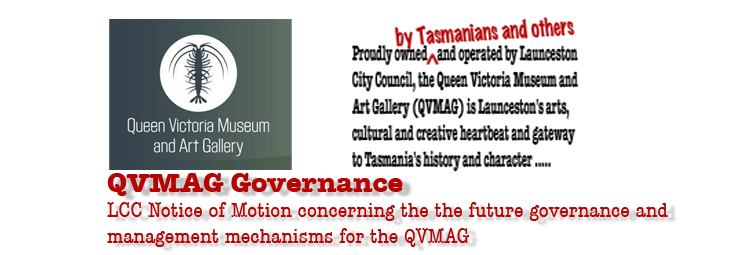
Serendipitously, Auckland Museum is reported in the
NZ Herald, by Brian Rudman on Friday Aug 20, 2010, as undergoing an upheaval that seems to contain all the elements evident in the QVMAG’s current crisis. Rudman reports that in New Zealand there has been a call to appoint a Commissioner to bring the Auckland Museum under the control of an appropriate governance and management process.
Given the circumstances now prevailing in Launceston it is proposed that the appointment of an
independent Commissioner, or group of Commissioners, to break the impasse at LCC in respect to the QVMAG’s governance and management has many attractions. Not the least being the recognition of the fact that such an institution needs sound and accountable governance and management regimes.
It is proposed that the Commissioner’s brief will be the oversighting of:
1. The short term ongoing operation of the QVMAG until a new Director is appointed;
2. The preparation of a five year Strategic and Marketing Plan for the QVMAG;
3. Consistent with that, the preparation of appropriate short term business cum enterprise plans for the operation of the QVMAG and the delivery of its programs;
4. Consistent with that, the auditing of the QVMAG operation, management structure and policy sets;
5. Consistent with that, the preparation of ongoing quality assurance benchmarks for the institution;
6. A consultation process that actively engages with the QVMAG’s Community of Ownership and Interest and that feeds into the above tasks;
7. The development of terms of reference for an appropriate governance model with a view to putting it in place as a stand alone arms length Board of Governors/Trustees for the QVMAG by July 1 2011;
8. The recruitment of a Director, or a Directorate, for the QVMAG with the capabilities and capacities to deliver on the QVMAG’s quality assurance regimes; and the implementation of the institutions program
– exhibition, research, community outreach etc. 9. Change management within the institution to ensure a smooth transition to the reformed governance and management paradigm.
11. A review of the institutions funding mechanisms
– Local, State, Federal Govt. plus otherThe course that LCC is currently on seems to be based upon a flawed and previously failed concept that further entrenches the QVMAG in a paradigm that ultimately leads to a lack of functional accountability. Too much is at risk to allow that to persist.
Alarmingly, the QVMAG’s Community of Ownership and Interest has by and large been left out of the accountability loop. Given that:
1. There is
$230 plus million of Tasmanians' cultural property, plus others’ intellectual property, invested in the QVMAG’s collections;
2. The QVMAG’s annual recurrent budget is in the order of
$5 million;
3. Launceston’s ratepayers collectively contribute well over
$3 million to the QVMAG’s annual recurrent budget;
4. Tasmania’s taxpayers contribute a
million dollars plus to the annual recurrent budget;
5. For the calendar year 2010
$10 million taxpayer and ratepayer funding is being expended on infrastructure for the QVMAG; and
6. There has been a need to dismiss the Director – there are inherent costs involved in this not to mention the lost opportunities flowing from the action.
Given all this there is a strong case to be put that there is a need to intervene to protect Tasmanians’ investment in both the institution and its collections.
It is asserted that the appointment of a Commissioner/s as set out above seems to be the only way forward that shows any promise of an equitable outcome for the QVMAG’s current staff, ratepayers, taxpayers and the institution’s Community of Ownership and Interest. Furthermore, it is asserted that the State Government has cause to review the level of recurrent funding for the QVMAG and call upon LCC to be truly accountable for the sound operation of the QVMAG.

 CONTENTS:
CONTENTS: 













